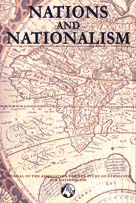Crossref Citations
This article has been cited by the following publications. This list is generated based on data provided by
Crossref.
Cusack, Tricia
2000.
Janus and Gender: Women and the Nation's Backward Look.
Nations and Nationalism,
Vol. 6,
Issue. 4,
p.
541.
Kuzio, Taras
2001.
Identity and Nation-Building in Ukraine.
Ethnicities,
Vol. 1,
Issue. 3,
p.
343.
Thomas, Elaine R.
2002.
Who Belongs?.
European Journal of Social Theory,
Vol. 5,
Issue. 3,
p.
323.
Shulman, Stephen
2002.
Nationalist Sentiments and Globalisation Preferences in Five Great Powers.
Global Society,
Vol. 16,
Issue. 1,
p.
47.
SHULMAN, STEPHEN
2002.
Challenging the Civic/Ethnic and West/East Dichotomies in the Study of Nationalism.
Comparative Political Studies,
Vol. 35,
Issue. 5,
p.
554.
Hearn, Jonathan
2003.
Big City: Civic Symbolism and Scottish Nationalism.
Scottish Affairs,
Vol. 42 (First Serie,
Issue. 1,
p.
57.
Colak, Yílmaz
2003.
Nationalism and the State in Turkey: Drawing the Boundaries of ‘Turkish Culture’ in the 1930s.
Studies in Ethnicity and Nationalism,
Vol. 3,
Issue. 1,
p.
2.
Janmaat, Jan Germen
2006.
Popular conceptions of nationhood in old and new European member states: Partial support for the ethnic-civic framework.
Ethnic and Racial Studies,
Vol. 29,
Issue. 1,
p.
50.
Naples, Nancy
2007.
The Social Regulation of Community: An Intersectional Analysis of Migration and Incorporation in the Heartland.
Journal of Latino/Latin American Studies,
Vol. 2,
Issue. 3,
p.
16.
LÆGAARD, SUNE
2007.
Liberal nationalism and the nationalisation of liberal values*.
Nations and Nationalism,
Vol. 13,
Issue. 1,
p.
37.
Ceobanu, Alin M.
and
Escandell, Xavier
2008.
East is West? National feelings and anti-immigrant sentiment in Europe.
Social Science Research,
Vol. 37,
Issue. 4,
p.
1147.
Ngeow, Chow Bing
2010.
Strategic Ambiguity and Differentiation: Ethnic and Civic Nationalist Discourses in Taiwan from 1945 to the 1990s.
Ethnopolitics,
Vol. 9,
Issue. 2,
p.
151.
Eugster, Beatrice
and
Strijbis, Oliver
2011.
The Swiss: A Political Nation?.
Swiss Political Science Review,
Vol. 17,
Issue. 4,
p.
394.
Ford, Robert
Tilley, James
and
Heath, Anthony
2011.
Land of My Fathers? Economic Development, Ethnic Division and Ethnic National Identity in 32 Countries.
Sociological Research Online,
Vol. 16,
Issue. 4,
p.
1.
Raney, Tracey
and
Berdahl, Loleen
2011.
Shifting Sands? Citizens' National Identities and Pride in Social Security in Canada.
American Review of Canadian Studies,
Vol. 41,
Issue. 3,
p.
259.
Mulcahy, Suzanne
2011.
Europe's Migrant Policies.
p.
130.
Koning, Edward A.
2011.
Ethnic and civic dealings with newcomers: naturalization policies and practices in twenty-six immigration countries.
Ethnic and Racial Studies,
Vol. 34,
Issue. 11,
p.
1974.
Westle, Bettina
2012.
Methods, Theories, and Empirical Applications in the Social Sciences.
p.
249.
Pöllmann, Andreas
2012.
Locating Ancestry in Notions of Britishness/Germanness.
Sage Open,
Vol. 2,
Issue. 4,
Andreouli, Eleni
and
Howarth, Caroline
2013.
National Identity, Citizenship and Immigration: Putting Identity in Context.
Journal for the Theory of Social Behaviour,
Vol. 43,
Issue. 3,
p.
361.


